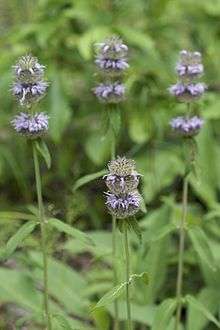Blephilia
| Blephilia | |
|---|---|
 | |
| Downy Pagoda-Plant (Blephilia ciliata) | |
| Scientific classification | |
| Kingdom: | Plantae |
| (unranked): | Angiosperms |
| (unranked): | Eudicots |
| (unranked): | Asterids |
| Order: | Lamiales |
| Family: | Lamiaceae |
| Genus: | Blephilia (L.) Raf. |
Blephilia (Downy Pagoda Plant or Wood Mint) is a genus of three species of flowering plants in the family Lamiaceae. They are all herbaceous plants native to eastern North America.[1][2] The species are most often found in thin woods and in granite and limestone soils. Blephilia hirsuta and Blephilia ciliata are considered threatened or endangered in some states. [3] [4]
Appearance
The genus includes only perennial species; they spread by both seeds and through stem division. Small purple flowers bloom on top of upper-leaf axils, often in several circular layers (hence the common name pagoda-plant). Leaves are bright green with whitish coloring underneath, pointed, lobed, and like all members of the mint family occur in opposite pairs. The species in this genus vary in size, but generally grow to about 1–2 feet and form in clumps.[4]
- Species
- Blephilia ciliata (L.) Benth. - (Downy pagoda-plant) widespread from Texas and Florida north to Quebec and Ontario
- Blephilia hirsuta (Pursh) Benth.- (Hairy pagoda-plant) - widespread from Texas and Georgia north to Quebec and Ontario
- Blephilia subnuda Simmers & Kral (Cumberland pagoda-plant) - endemic to northeastern Alabama
References
- ↑ Kew World Checklist of Selected Plant Families
- ↑ Biota of North America Program, 2013 county distribution maps
- ↑ USDA plant profile. Retrieved on July 16, 2007
- 1 2 Lady Bird Johnson Wildlife Center Web site. Retrieved on July 16, 2007